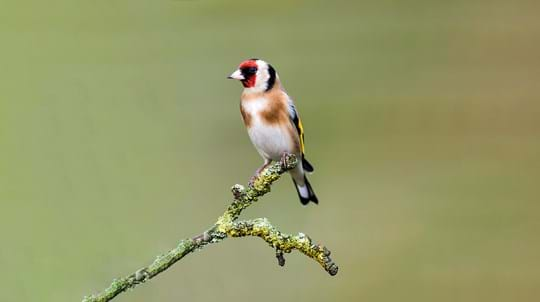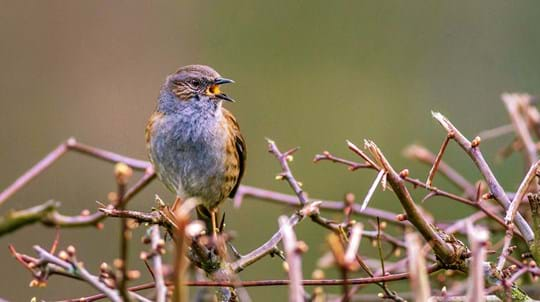Swifts, swallows and martins: easy ID guide

Nature's Calendar
Their arrival is a welcome sign that spring is here. And although these darting, diving and acrobatic birds look similar, there are important differences. Learn how to tell which is which with our easy guide.
Swift
Extremely fast high fliers, swifts are known for their unrivalled aerial abilities. They often spend their entire lives on the wing including sleeping, mating, and drinking.
A group of swifts is called a 'scream', and for good reason. You'll often hear them before you see them!
How to identify
- Dark, sooty brown, swifts may appear black against the sky as they swoop and glide at high altitude.
- Wide, crescent-shaped wings.
- Short forked tail.
- Body to 16cm long.
- Wingspan 40cm.
- Often spotted flying at higher altitudes.
When and where to see
Arrival: May and you'll see them throughout summer to the end of July when they depart on their migration.
Where to see: above farmland, towns and cities.
Listen to a swift call
Swift call
Audio: Audio: Nick Talbot / xeno-canto.org
Swallow
Swallows start arriving in the UK in April. They are not related to swifts but look similar and have evolved the same traits to help them efficiently catch airborne prey.
According to the British Trust for Ornithology, a recent run of mild winters has led to a small number of swallows overwintering in the UK instead of migrating south.
How to identify
- Swallows are glossy, dark blue-black on top with a white underside and a red throat.
- Scythe-shaped wings with smaller wingspan than swift.
- Elongated, forked tail.
- Body 15 to 20cm long.
- Wingspan 32cm.
- Often spotted flying low to the ground or at tree height in darting and gliding motions or perching on telegraph wires and aerials.
- Swallows tend to make their presence known by tweeting and chirruping.
Where and when to see
Arrival: April and you'll see them throughout summer to the start of October when they depart.
Where to see: they prefer lowlands, especially open fields, or meadows where there are plenty of insects.
Listen to a swallow call
Swallow call
Audio: Audio: Craig Brookes / xeno-canto.org
House martin
Smaller than swifts or swallows, you’re likely to see house martins zooming out from under the eaves of houses in the mornings and evenings.
House martins get their name from their habit of nesting in and around houses which act as an alternative to the steep cliffs the species once relied on.
How to identify
- House martins have a blue/black back, head and wings.
- White underside and rump.
- Small forked tail.
- Body 13cm long.
- Wingspan 26cm to 29cm (smaller than swifts and swallows).
Where and when to see
Arrival: April and throughout summer to the end of September.
Where to see: towns and villages across the UK especially where there is an abundance of insects close to open fields, woodland and near water.
Listen to a house martin call
House martin call
Audio: Audio: Craig Brookes / xeno-canto.org
Sand martin
The smallest of the four species listed here, sand martins inhabit watercourses and wetlands and are unique in creating burrows for nesting.
The scientific name for sand martin, Riparia riparia, is derived from the Latin word riparius which means 'of the riverbank'.
How to identify
- Sand martins have dark brown wings, head and upper parts.
- White underside except for a distinctive brown bar across the chest.
- Body 12cm long.
- Wingspan 28cm (smallest of the four).
- Distinctive swirling flight pattern.
- Characteristic of river banks and wetlands where they burrow in sandy areas.
Where and when to see
Arrival: end of March and throughout summer to July (bit sometimes they stay as late as September).
Where to see: along rivers, lakes, and wetlands, but also man-made areas like farmland and gravel pits. Spot their burrow holes along sandy banks and ledges.
Listen to a sand martin call
Sand martin call
Audio: Audio: Garbriel Leite / xeno-canto.org

Spotted your first swift of the year yet?
More on bird identification
Blog
Bird song identification: songs and calls for beginners
Kayleigh Jacobs-Rutter • 13 Feb 2024

Blog
British finches: identification guide and songs
Amy Lewis • 28 Feb 2019

Blog
Bird song identification: UK garden birds
Amy Lewis • 01 May 2020
Blog
11 rare birds in Britain's woodland
Charlotte Varela • 10 Apr 2019

Blog
Bird song: Blackcap, chiffchaff and more
Hannah Vickers • 03 Apr 2020







